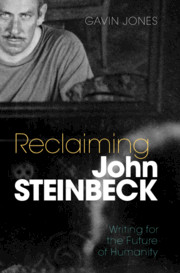Book contents
- Reclaiming John Steinbeck
- Reclaiming John Steinbeck
- Copyright page
- Dedication
- Contents
- Figures
- Acknowledgments
- Introduction Loving and Hating Steinbeck
- Chapter 1 Short Stories in School and Lab: “Tularecito” and “The Snake”
- Chapter 2 Drought, Climate, and Race in the West: To a God Unknown
- Chapter 3 Race and Revision: “The Vigilante” and “Johnny Bear”
- Chapter 4 Becoming Animal: Theories of Mind in The Red Pony
- Chapter 5 What Is It Like to Be a Plant? “The Chrysanthemums” and “The White Quail”
- Chapter 6 On Not Being a Modernist: Disability and Performance in Of Mice and Men
- Chapter 7 Emergence and Failure: The Middleness of The Grapes of Wrath
- Chapter 8 Borderlands: Extinction and the New World Outlook in Sea of Cortez
- Chapter 9 Mexican Revolutions: The Forgotten Village, The Pearl, and the Global South
- Epilogue The Aftertaste of Cannery Row
- Notes
- Index
Chapter 5 - What Is It Like to Be a Plant? “The Chrysanthemums” and “The White Quail”
Published online by Cambridge University Press: 02 July 2021
- Reclaiming John Steinbeck
- Reclaiming John Steinbeck
- Copyright page
- Dedication
- Contents
- Figures
- Acknowledgments
- Introduction Loving and Hating Steinbeck
- Chapter 1 Short Stories in School and Lab: “Tularecito” and “The Snake”
- Chapter 2 Drought, Climate, and Race in the West: To a God Unknown
- Chapter 3 Race and Revision: “The Vigilante” and “Johnny Bear”
- Chapter 4 Becoming Animal: Theories of Mind in The Red Pony
- Chapter 5 What Is It Like to Be a Plant? “The Chrysanthemums” and “The White Quail”
- Chapter 6 On Not Being a Modernist: Disability and Performance in Of Mice and Men
- Chapter 7 Emergence and Failure: The Middleness of The Grapes of Wrath
- Chapter 8 Borderlands: Extinction and the New World Outlook in Sea of Cortez
- Chapter 9 Mexican Revolutions: The Forgotten Village, The Pearl, and the Global South
- Epilogue The Aftertaste of Cannery Row
- Notes
- Index
Summary
Raised in the agriculturally rich Salinas Valley, Steinbeck was naturally fascinated by gardening, vegetables, and plant life in general. If Steinbeck’s experiments with animal consciousness are compromised by uncritical racial ideology, then his stories about plants have more radical implications. “The Chrysthanthemums” from The Long Valley explores the intimacy of the human-plant connection and imagines a form of human consciousness that verges on the passive receptivity of a plant-like existence as pure growth. Steinbeck’s approach to post-human subjectivity continues in “The White Quail,” which returns to interests in gardening and eugenics. Through its imagery, allusions, and theme of marriage, the story dismantles the assumptions of eugenics by questioning the symbolic identification suggesting that selective breeding of plants translated into possibilities for human betterment. A coda on The Grapes of Wrath and drought photography explores representations of human and vegetable reactions to drought to make clear the achievement and the limits of Steinbeck’s forays into alternate states of human consciousness in his stories.
- Type
- Chapter
- Information
- Reclaiming John SteinbeckWriting for the Future of Humanity, pp. 89 - 107Publisher: Cambridge University PressPrint publication year: 2021

